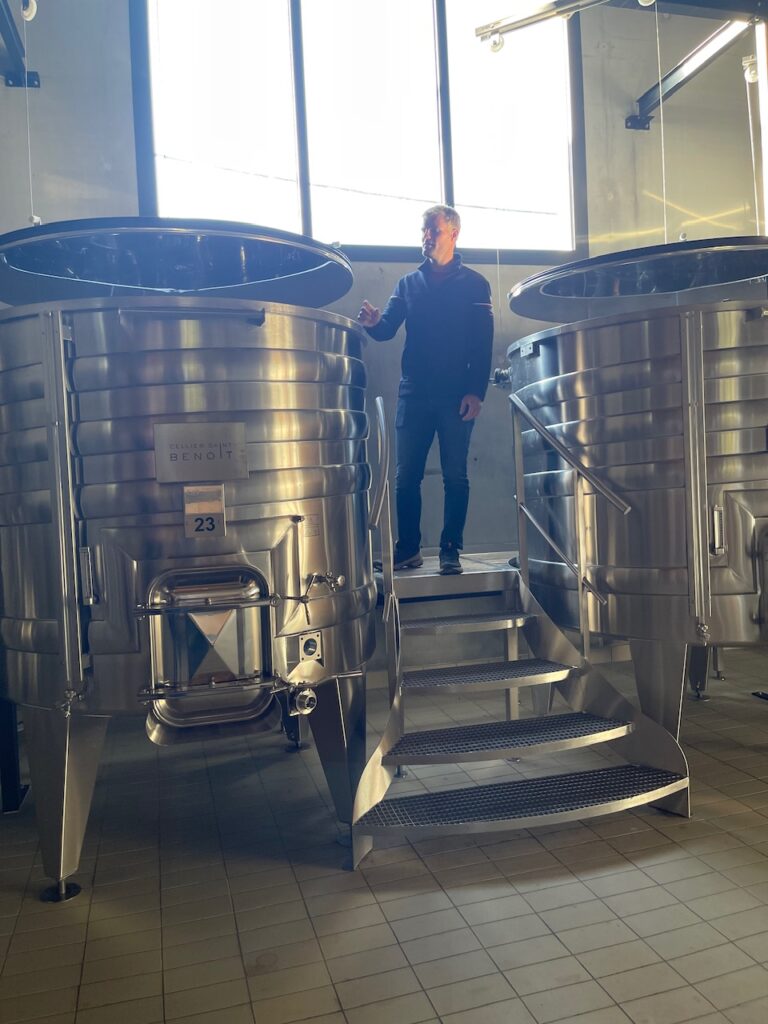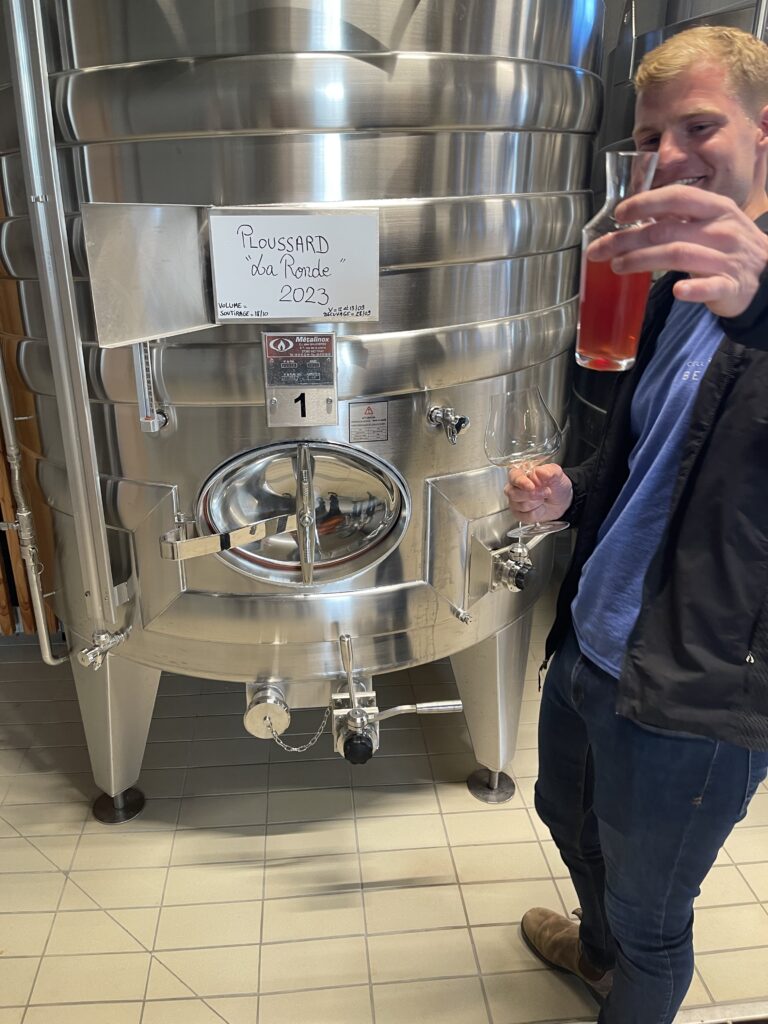This is my second visit to Pupillin and Benjamin Benoit at the estate Le Cellier Saint-Benoit.
I was very excited by the first visit where I got some very interesting new wines in the book – you could actually call it an introduction to the red grape varieties that are grown in Jura aside from the well-known Pinot Noir.
Benjamin Benoit has had frost issues in the vineyards during recent years, and this underlines that Jura is a cooler and more savage area than Burgundy.
With Global warming, it is starting to be stable and possible to make good reds even in lesser and more problematic years … but don’t expect miracles as the stability of some of the lesser-known grapes can in general quickly get problematic when the PH increases into the exciting area.
So, no miracles, and the tastings confirm that Pinot Noir is still the safer choice in red Jura.

Fantastic Pupillin
Pupillin is located on the southwestern slope of the Jura mountains, and it has a tremendous landscape, with complex geology that accommodates different grape varieties.
The views are outstanding, and an hour-long trip through the vineyards left me flabbergasted by the beauty of this sunny day.







The terroirs of the Pupillin vineyards are characterised by sunny, south-facing, limestone slopes with great variation among the soil types. The altitude is around 350 metres/1150 feet above sea level, and high trellising is used to some extent.
Frost is an issue in the Jura, just as it is in other wine-growing regions, and about a third of the vines had their potential crop more or less destroyed by the hard April frost of 2024.
Arbois-Pupillin produces white, red, and rosé wines, made from white grapes Chardonnay and Savagnin and red grapes Pinot Noir, Trousseau, and Poulsard – also known as Ploussard, the dominant grape in the area. Trousseau is, by the way, known as bastardo in Madeira and mainland Portugal. Even melon – the grape – is produced by Benjamin Benoit.
Benjamin Benoit
Benjamin Benoit was born in 1995, so he’s not yet 30. He went to the technical high school in Beaune to study viticulture and winemaking.
He has worked for Arnoux-Lachaux and Amelie Berthaut, both estates well known to the Winehog, and both estates that take good care of the young people who work there. People like to criticise vignerons like Charles Lachaux, but, in fact, he is very generous with his knowledge towards vignerons and wine lovers who care to listen.
While Benoit was working for Amelie Berthaut, his father sadly passed away, leaving him the family estate in Pupillin. A large part of the grapes that year were sold to the local cooperative, the Fruitière Vinicole d’Arbois. Only two hectares of 6.5 ha were bottled under the family label – the rest was sold to the cooperative.
Benoit has since taken most of the vineyards back for his own production, and he is now farming five of the 6.25 hectares – a much larger estate.
For his bottles, Benoit chose Louise Lachaux as the label designer; always a fine creative decision.
Le Cellier Saint-Benoit …
Regarding the Jura, many wine lovers are discovering – and drinking – the whites. I do understand this, but for me, the reds from Le Cellier Saint-Benoit are at least just as interesting.
The reds of Pupillin
Pinot noir is, of course, the king of reds. But if one treasures light, floral wines, Pupillin can offer some real treats from Trousseau and Ploussard, if they are well-made.
Ploussard is the most common red grape in the Jura, and a true local. It is, in the hands of Benjamin Benoit, a floral treat: light in colour, and when made with a light hand, transparent and delicate. The minerality is beautifully present and gives the wine liveliness and complexity. The acidity is lively, with forward freshness. Vin de soif springs to mind, as the depth and complexity are somewhat limited. These are wines painted with broad, yet slightly fragile strokes. Some will criticise Ploussard for being thin, but I love these wines for their lively lightness.

Trousseau is the other native Jura red grape. It’s on the more powerful side, with quite an alcoholic potential if not harvested in time and vinified carefully. I have not tasted many wines from this grape, but made with a light hand, it can be controlled. Still, as the Portuguese nickname bastardo indicates, it’s bolder, more intense, and spicier than Ploussard. I need to taste more widely to have a firmer understanding of this variety.
Pinot Noir from Pupillin is darker, deeper, and more complex than Ploussard. It makes a larger-scaled wine, and one that is a bit more serious. While I enjoyed both, the Pinot makes one want to reflect on the flavours and impressions, whereas the expressive Ploussard simply treats your palate with joyful impressions, straightforward and direct pleasure.
There is no reason to argue over whether the Ploussard or the Pinot is better. All being equal, the answer is a given. But at the right time, with the right friends or food, Ploussard is a blessing – to my palate at least.
Ploussard Cuvées
Benjamin Benoit and Le Cellier Saint-Benoit make several red wines, and being on foreign soil, I cannot yet say anything intelligent about the intricacies of these different cuvées.
Cuvée de Trousseau
- Trousseau Côte de Feule
Cuvée de Ploussard
- Ploussard Le Grapiot
- Ploussard Côte de Feule
- Ploussard Les Chambines
- Ploussard Les Rouges
- Ploussard La Ronde
Cuvée de Pinot Noir
- Courbes Raies
To say I have full control over my understanding of the different Ploussard cuvées would be the overstatement of the year. I am only starting to learn.
This is new turf for the Winehog, and as I love Benjamin Benoit’s wines, I will definitely taste and explore more.
Tasting the 2023s
Tasting the 2023 reds currebtly was a fine but also somewhat bumpy ride, as the high pH of some of the wines in some cases introduced some issues at this stage of the elevage…
You need to login as a Premium subscriber to read the rest of this article. If you are not a Premium Subscriber, use the subscribe function and sign-up.

 - A true vin d’émotion – a Burgundy of passion
- A true vin d’émotion – a Burgundy of passion - A truly hedonistic wine – lively and enjoyable
- A truly hedonistic wine – lively and enjoyable - A vivacious wine for pure indulgance
- A vivacious wine for pure indulgance - A potential vin d´émotion - frais et léger
- A potential vin d´émotion - frais et léger
Leave a Reply
You must be logged in to post a comment.